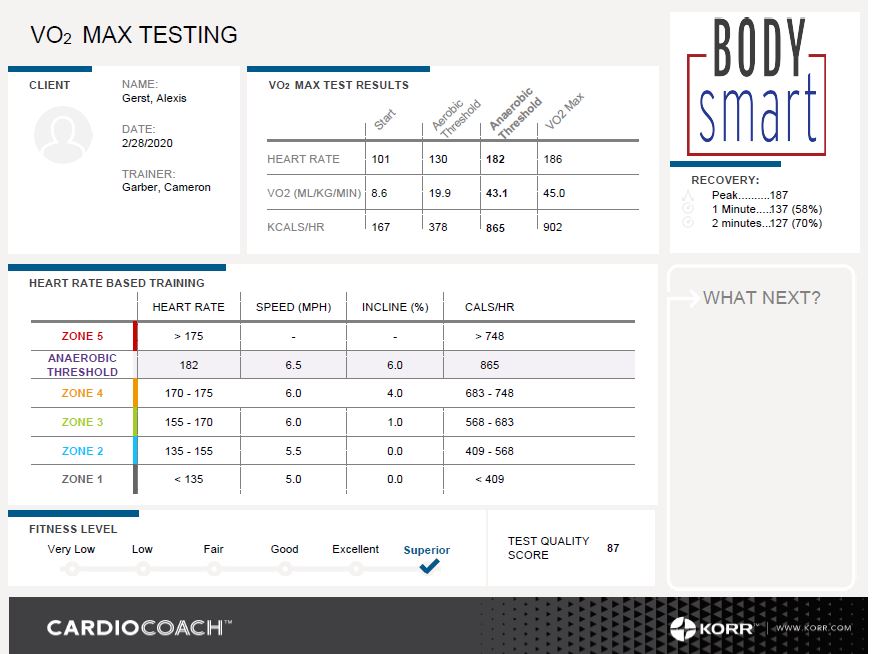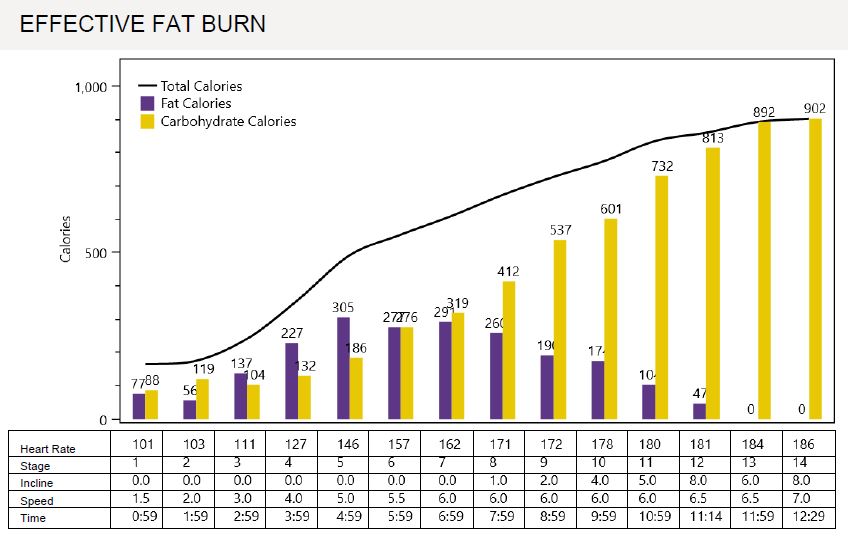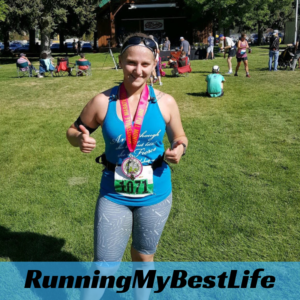Metabolic testing for runners can give an accurate picture of how many calories their body burns, what heart rate zones to train in, where their aerobic and anaerobic thresholds are, and how many carbohydrate versus fat calories are burned at any given heart rate.
If you feel like the whole “calories in versus calories out” equation just isn’t working with your body, then it’s probably time for you to try metabolic testing for runners.

While calories do have a large impact on the mathematical equation determining your weight, they don’t tell the whole story. Hormones, stress, nutrient quality, and sleep can all impact your weight loss, gain, or maintenance in various ways.
Plus, how do you even figure out the true number of calories your body needs?
There is a myriad of different “Resting Metabolic Rate” calculators out there, but I’ve found that my calculated rate can vary by over 200 calories per day, which is a pretty big range to try and plan for. When you factor on top the uncertainty in measuring actual calories burned during exercise, no wonder so many people are frustrated with the “calories in versus calories out” equation. A few hundred calories of error in your metabolic rate, plus a variance in actual calories burned could easily add up to the 500 calorie-per-day deficit recommended for healthy weight loss.
Want to erase some of this uncertainty? This is where metabolic testing comes in for runners.
What is Metabolic Testing?
Metabolic testing is simply measuring the process in which your body converts food and drink into energy.
Your metabolism is the biochemical process where your body combines calories with oxygen to release the energy your body needs to function. Even when you are at rest, you body still needs energy to carry out bodily functions such as breathing, pumping blood through your body, circulating nutrients to your cells and waste away from your cells, plus adjusting hormone levels.
Benefits of Metabolic Testing for Runners
Metabolic testing is very beneficial, especially for distance runners. It can take the guesswork out of many different factors around training and nutrition.
Specifically, metabolic testing can answer several important questions where most runners in training simply guess:
- What is my true resting metabolic rate (RMR)?
- How many calories do I actually burn in a day (RMR + Activity)?
- How efficiently does my body burn fat for energy?
- What are my body’s heart rate zones, and how does this affect the paces/zones I train in?
- At what heartrate does my body burn more carbohydrates than fat, and how does this affect my fueling strategy for training and races?
- What is my aerobic threshold?
- What is my VO2 Max?
Metabolic testing gives runners the specific answers to these questions for YOUR body at a given fitness level and body weight can be very helpful to dial in your training and nutrition for maximum performance.
There are two components of a metabolic test: resting and exercise.
Resting Metabolic Test
The resting metabolic test measures the concentration of oxygen breathed out, which directly correlates to calories burned. Because of this direct correlation, an accurate measurement of oxygen consumption is an effective measurement of calorie consumption.
The resting test takes about 10-15 minutes and requires that you relax as much as possible. It’s actually a good thing if you fall asleep for a quick nap during your test! This will help the test accuracy by getting you as close as possible to a true resting level.
You will wear a mask over your face connected to a tube, which directs the air you exhale into a machine for measurement. The feeling is pretty much the same as wearing a respirator mask. You will also wear a heart rate monitor strap.

At the conclusion of my resting metabolic test, my resting metabolic rate was about 100 calories/day HIGHER than could be expected for my age, gender, height, and weight. However, my body fat is relatively low and I have a high amount of muscle mass for my height and weight. This means I burn more calories just to maintain my body than would another female my same age, height, and weight.
Higher resting metabolic rate = more calories burned without even trying. Booyah! This is why I strength train 😉
[convertkit form=1015226]
After you finish your resting test, it’s time to move on to the exercise test.
Exercise and VO2 Max Test
For the exercise test, you’ll wear the same mask over your mouth and nose, which is held onto your head by a harness. The heart rate strap will remain for accurate heart rate measurements. You’ll jump on the treadmill with the tube hooked up to the machine that will measure the air you exhale.

After you warm up, then the test will start. At the start of the exercise test, you will be walking at a very easy, painstakingly slow pace to establish a baseline. Then, over the course of 10-20 minutes, the intensity of the work will increase gradually until you reach the anaerobic threshold.
Now…you might be worried about running in a mask.
It’s not exactly a pleasant feeling, but it really isn’t that terrible either. Until you start sweating, then it’s pretty gross. But just remember you’re getting really valuable data that you can use to help get to the next level in your training, so keep pushing through! (Or at least that’s what I told myself) The longer you can go, the more data you get.
After the point where the system detects your anaerobic threshold OR when the lactic acid builds up so much that you just can’t keep going, you will begin the cool down phase and allow your heart rate to recover.
The testing software then compiles the data into a report for you to use, which contains several data points that can guide your training. One of these is your VO2 Max, which is considered the “gold standard” measure of overall fitness.

How Runners Can Get a Metabolic Test
Does all this sound pretty interesting?
I thought it did, so I took the leap and FINALLY scheduled a test after over a year of thinking it would be “something cool to do.”
As I shift from a weight loss mindset and calorie intake to a weight maintenance and running performance mindset with my nutrition, I wanted to get an accurate read on how many calories I actually need to eat.
The metabolic test was a key in helping me answer the question.
I got with Dr. Cameron Garber at Body Smart Physical Therapy in South Ogden, Utah for my metabolic test. If you’re in the Utah area and want to do your metabolic test at Body Smart, mention “Running My Best Life” for $50 off your test. You can contact Body Smart at 801-479-4471 or at [email protected].
What to Expect on Test Day
Metabolic testing including both the resting and exercise tests takes about 1-2 hours of measurement and testing.
As with most baseline health tests, you will fast for at least 4-8 hours prior to your test. For this reason, it is most convenient to schedule your test in the morning. You can drink plain water, but no drinks with calories or caffeine. For the most accurate results, the instructions also mention no exercise or vigorous sexual activity the day prior to the test, so you’ll want to schedule it around your training plan accordingly, if you’re currently training for a race.
Plan to wear comfortable exercise clothing for the duration of the appointment. When you arrive, the first measurements will be weight, height, and body fat. After that, you’ll do the resting metabolic rate portion of your test. The last component of the test is your exercise test.
Finally, you’ll be able to see the results from your testing and go over what all the numbers mean for you and your running.
How to Use Your Metabolic Test Results
This is the best part!
After you have all of this valuable information, it’s time to put it to good use for weight loss/maintenance/gain, fueling, and training so you can improve your running!
First, I’ll start with my resting test.
Resting Metabolic Rate Test Results
For your resting test, you’ll get a chart of the data and measurements taken during your test, and you’ll get a results summary sheet that might look like this.

This indicates that my resting metabolic rate is 1,496 calories. Which means the ABSOLUTE MINIMUM number of calories I should eat per day are 1,496.
Eating less calories than your Resting Metabolic Rate per day requires medical supervision.
This is why it is dangerous for so many weight loss programs to blanket recommend that women eat 1,200 calories per day for weight loss. It isn’t healthy, and it’s not sustainable. Through the 24 pounds lost over the past 2 years, I’ve found that the most effective calorie intake for me personally to lose weight is closer to 1,800 calories.
Calculating Maintenance Calorie Intake
Now, this chart indicates 2,094 should be my calorie intake for maintenance.
This is because I set my activity level to my “normal” activity level with 3-4 runs plus 1-2 strength sessions per week. It’s not accounting for the activity level of my current marathon training plan, so my real maintenance level for marathon training is around 2,300-2,400 calories per day. This number will go up further as my mileage peaks later in training.
As of 2 weeks after my metabolic test, I’m averaging 2400-2500 calories per day intake and my weight is still trending down on my marathon training workload, while I still feel full and well-fueled following the 5 Nutrition for Runners Eating Habits.
Related: Nutrition for Runners: 5 Core Eating Habits that Will Make You Faster
Finally, I feel like I need to address the little box that says: “Your BMI is 25.23, which classifies you as Overweight”.
BMI can suck it, and I’m honestly not sure why tests like this still put BMI on the chart. Body Mass Index (BMI) is a simple calculation as a function of your height and weight based on the national population. Although still used as a “quick” measurement indicator, it’s obsolete and doesn’t tell the whole story.
My body fat measurement was taken at the same time, which showed 24% body fat. Case in point: I have more muscle on my body than the average person my height and weight, which gives me a BMI slightly higher than “normal”.
Okay, rant over.
While I’m probably not to the final destination on my weight loss journey, I’ve put a pause on my weight loss goals while I train for a full marathon. I’m totally happy and content with where my weight is at right now, and I’m content with how I look. My closet is already undergoing a huge shift where I’m getting rid of my old clothes that are loose and baggy on me, and I’m swapping out for smaller sizes 1-2 pieces of clothing at a time.
Let’s talk about the exercise test.
Exercise Test Results (VO2 Max Test)
My Exercise Metabolic Test for Runners results were several pages longer than my resting test, because a TON of data was collected while I ran.
First is the summary page.

The anerobic threshold is bolded, and my anerobic threshold heart rate is 182. Interestingly enough, my average heartrate during my 10k in which I PR’d (the day after this VO2 Max test), was 182. Clearly, that heart rate is the maximum my body can sustain.
My VO2 max is 45.0, which puts my fitness level in the “Superior” category.
The most valuable data on this page to put to use in my training, however, is the Heart Rate Based Training zones.
According to the principles of 80/20 Running, I should spend most of my training in Zone 2, which is between 135 – 155 for me. This also feels extremely easy to me…and that’s the point. It should be.
Related: 80/20 Running: Why You Need to Slow Down
I’ll admit, I have been guilty of pushing my easy runs a little harder/faster than I should have because it felt easy and I assumed I was getting fitter, so I should be able to do my easy runs faster. But I wasn’t paying attention to my heart rate. I was just “used to” how my heart rate felt at a faster effort.
After getting my zones on this test, I’m recommitting to following the 80/20 Rule and actually watching my heart rate on my easy runs…even if that means my pace slows to 12 or 13 minutes per mile when I was previously running “easy” at a 10:30 pace.
Plus, as my mileage increases in training for my first marathon, running the majority of my miles slow will be a key element to injury prevention. After all, the goal is to get to the starting line healthy and able to run 26.2 miles, not to break down on the way there because of an arbitrary time goal!
Exercise Test Results Continued: Effective Fat Burn
The Effective Fat Burn chart is probably one of the most valuable charts for distance runners, specifically half marathon and full marathoners.
Ever wondered how many carbohydrates your body burns during a long run? What about during a race?
Metabolic testing is a valuable way for runners to see when their carbohydrate calorie burn begins to exceed fat burn. This chart literally calculates it for you (well in this case, for me).

You can see how the portion of fat calories burned compared to carbohydrate calories burned shifts in proportion to my heart rate (read: effort and intensity level).
The last half marathon I ran was back in October, and my average heart rate was 172 (Thanks Garmin!). If I find my heart rate of 172 on the chart, I can see that I burn 190 calories of fat per hour and 537 calories of carbohydrate per hour at that intensity. For reference, 537 carbohydrate calories divided by 4 calories per gram of carbohydrate equals 134 grams of carbohydrate burned per hour!
Per hour of running at a heart rate of 172 beats per minute (for me):
537 carbohydrate calories burned / 4 calories per gram of carbohydrate = 134 grams of carbohydrate burned
Now, all of the sudden Matt Fitzgerald’s recommendation in The New Rules of Marathon and Half Marathon Nutrition to aim for 30-60 grams of carbohydrate per hour intake seems conservative!
Since our muscles hold a considerable amount of carbohydrate already, we can assume that I’ll avoid hitting the wall if I replace just half of the carbohydrates burned per hour. Half for me would be 67 grams of carbohydrate per hour, still higher than Fitzgerald’s recommendation.
Now it makes more sense why some recommend even 80-100 grams per hour, if the athlete’s stomach can tolerate it.
Related: The Complete Guide on How to Fuel a Half Marathon
If metabolic testing for runners interests you, get in touch with Dr. Cameron Garber at Body Smart to schedule your test, and grab a copy of my FREE fueling strategy cheat sheet below.
[convertkit form=876847]
Have You Ever Done a Metabolic Test?
Were the results what you expected, or different?

Run Happy,
Alexis
- Nailing Your Marathon Hydration Strategy: A Comprehensive Guide
- Conquering Marathons in the Cold: A Comprehensive Guide
- Harnessing the Power of Technology for Successful Marathon Training
- Mastering the Marathon: The Ultimate Guide to Nutrition and Training
- Ultimate Guide to the Top 5 Running Shoes for Beginners in 2023
About Me: I’m Alexis, Founder of RunningMyBestLife! I am an avid recreational runner, half marathoner, wife, dog mom, busy professional, downhill skier in Northern Utah. My mission is to help new enthusiasts fall in love with the sport of running. I believe that running is a catalyst to taking control of your life and living your best life by design. Learn More –>